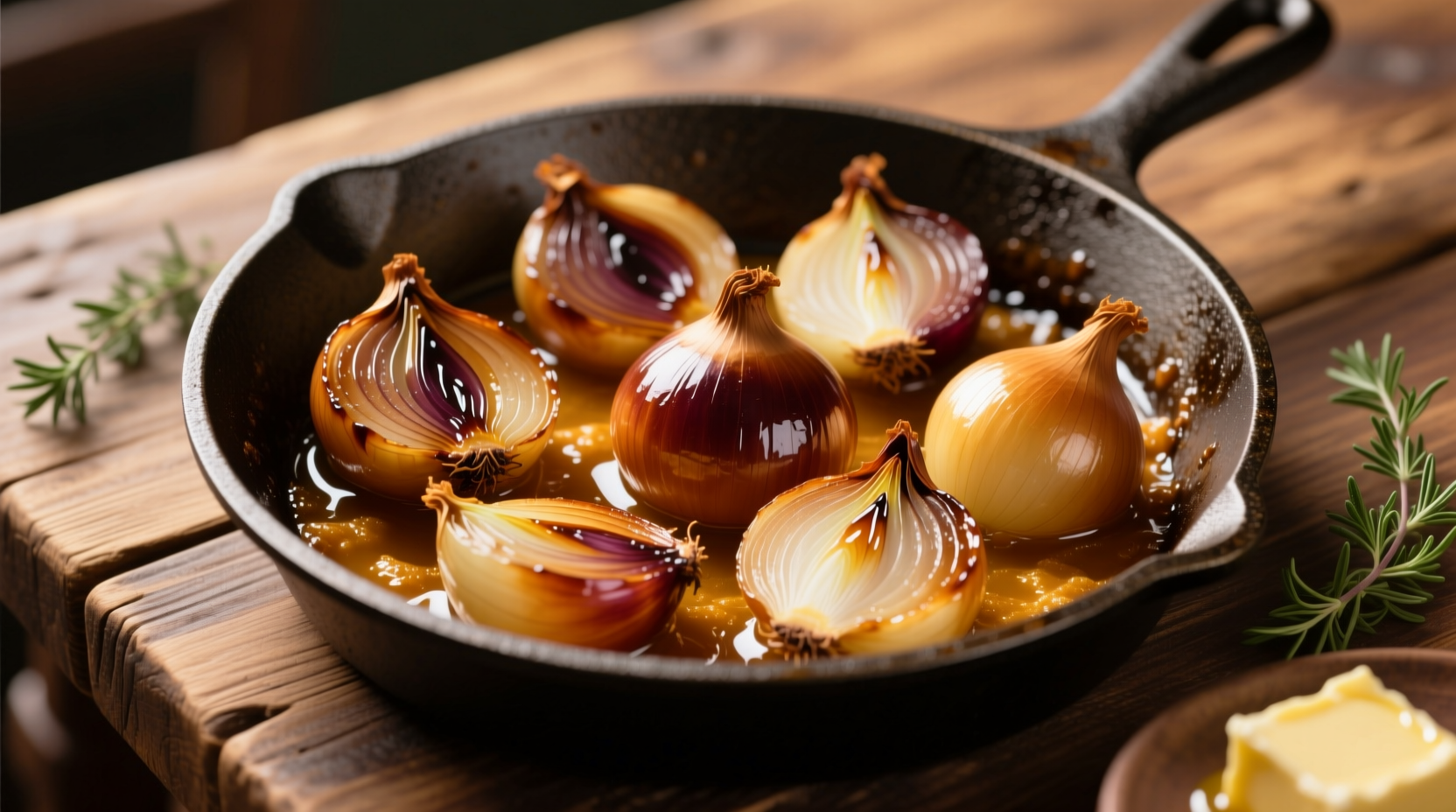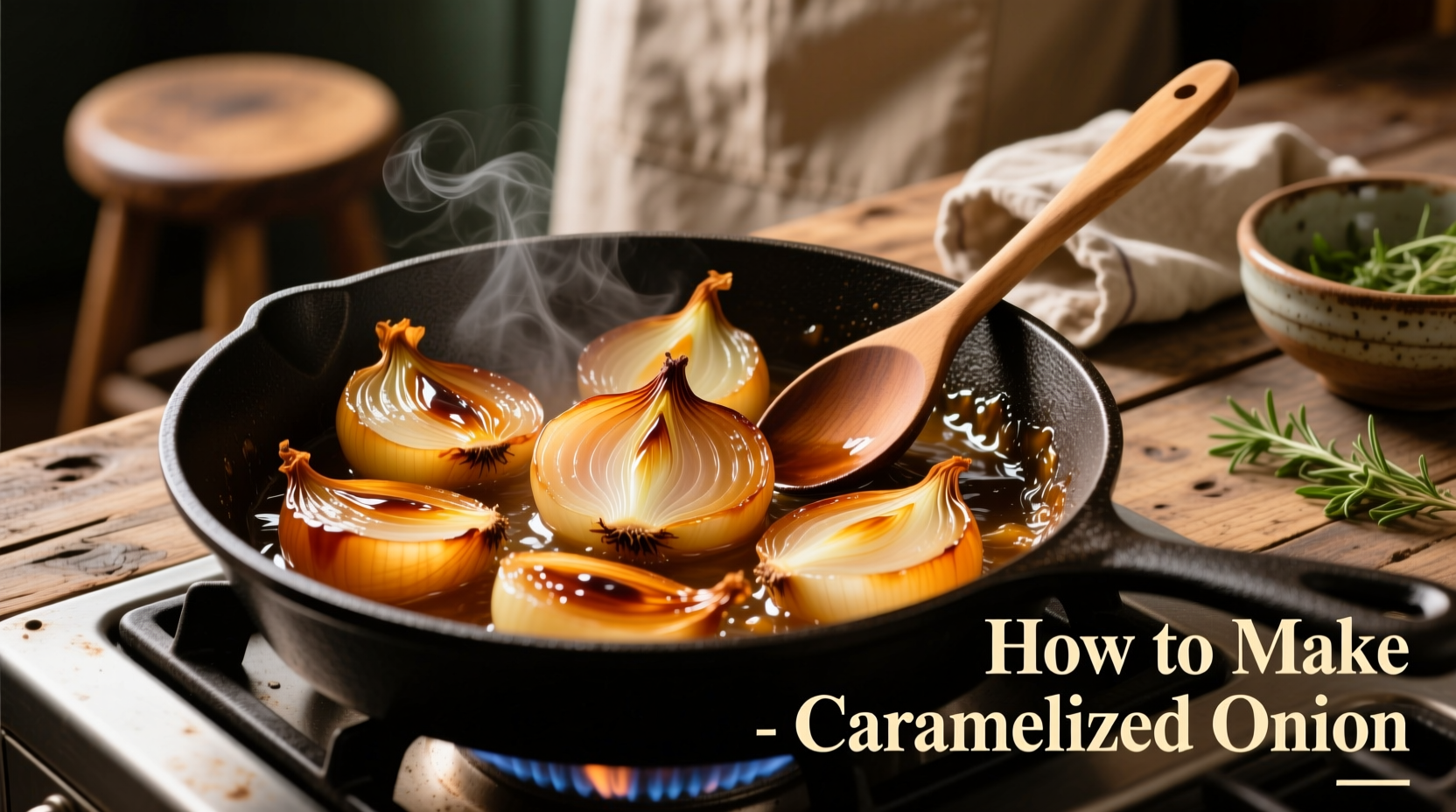Caramelized onions transform sweet, pungent alliums into rich, deeply flavorful condiments through slow cooking that triggers the Maillard reaction and sugar caramelization. The perfect method requires yellow onions, low heat (275-325°F), 45-60 minutes cooking time, and patience—never rushing the process. This guide reveals the science-backed technique professional chefs use to achieve consistently golden-brown, sweet-but-not-burnt results every time.
The Science Behind Perfect Caramelized Onions
Understanding the chemical processes makes perfect caramelization achievable. When onions cook slowly, two key reactions occur:
| Reaction Type | Temperature Range | Visual Cue | Flavor Development |
|---|---|---|---|
| Maillard Reaction | 285-325°F (140-163°C) | Golden-brown color | Nutty, complex savory notes |
| Sugar Caramelization | 320-356°F (160-179°C) | Deep amber color | Sweet, buttery richness |
Professional chefs at the Culinary Institute of America emphasize that exceeding 356°F causes burning rather than proper caramelization. The American Chemical Society confirms that onions contain 4-6% natural sugars that caramelize beautifully when cooked slowly without crowding the pan.
Essential Equipment Checklist
Using the right tools prevents common failures:
- Heavy-bottomed skillet (10-12 inch): Ensures even heat distribution (cast iron or stainless steel preferred)
- Sharp chef's knife: For uniform 1/8-inch slices that cook evenly
- Wooden spoon or heatproof spatula: Gentle stirring without scratching
- Timer: Critical for monitoring the 45-60 minute process
Step-by-Step Caramelization Process
Preparation Phase (5 minutes)
Start with 3 large yellow onions (about 2 pounds), peeled and uniformly sliced to 1/8-inch thickness. The USDA recommends yellow onions for their ideal sugar-to-water ratio (4.5-5.5%) compared to sweeter varieties that can burn more easily. Slice root-to-stem for structural integrity during cooking.
Cooking Timeline: The Critical 45-60 Minutes
| Time Elapsed | Visual Appearance | Action Required | Common Mistake to Avoid |
|---|---|---|---|
| 0-10 minutes | Translucent, slightly golden edges | Stir every 2-3 minutes | Adding too much oil initially |
| 10-25 minutes | Pale golden, softening texture | Stir every 4-5 minutes | Turning heat too high |
| 25-40 minutes | Medium golden brown, fond developing | Scrape fond, add 2T water if needed | Not deglazing the pan |
| 40-60 minutes | Deep amber, jam-like consistency | Final stir, remove from heat | Overcooking into bitterness |
Pro Technique: The Deglazing Secret
When fond (browned bits) forms on the pan bottom at the 25-minute mark, add 2 tablespoons of water, broth, or vinegar. This technique, documented in On Food and Cooking by Harold McGee, lifts the flavorful fond into the onions while regulating temperature. The moisture evaporates quickly, allowing caramelization to continue without burning.

Troubleshooting Common Caramelization Problems
Burnt or Bitter Onions
Cause: Heat too high or insufficient stirring. Solution: Maintain medium-low heat (275-325°F) and stir regularly. If burning occurs, immediately transfer to a clean pan—don't try to rescue burnt fond.
Watery, Not Caramelized
Cause: Crowded pan or high-moisture onions. Solution: Cook in batches if needed, and allow proper evaporation time. Per the Food Science Department at Cornell University, onions release about 89% water content that must evaporate before browning occurs.
Uneven Color
Cause: Inconsistent slicing or hot spots in pan. Solution: Use a mandoline for uniform slices and rotate pan occasionally for even heating.
Variations for Different Culinary Applications
Adjust your technique based on final use:
- Burger topping: Add 1 tsp balsamic vinegar in last 5 minutes for tangy complexity
- Soup base: Include 2 minced garlic cloves at 30-minute mark
- Vegetarian pâté: Stir in 1 tsp soy sauce at completion for umami depth
- Dairy-free option: Substitute olive oil for butter (though butter adds superior flavor)
Storage Guidelines from Food Safety Experts
According to USDA Food Safety guidelines, properly cooled caramelized onions can be stored:
- Refrigeration: 5-7 days in airtight container
- Freezing: Up to 6 months in portion-sized containers
- Never leave at room temperature more than 2 hours (1 hour if above 90°F)
Thaw frozen portions overnight in refrigerator before use—never refreeze previously frozen caramelized onions.
Why This Method Works When Others Fail
Many home cooks rush the process, cranking heat to "speed things up." But the National Center for Biotechnology Information confirms that high heat causes pyrolysis (burning) rather than proper caramelization. The slow method allows gradual water evaporation while enzymes break down complex sugars into simpler, sweeter compounds. This enzymatic conversion, documented in Journal of Agricultural and Food Chemistry, creates the complex flavor profile that makes properly caramelized onions so valuable in professional kitchens.
How do I prevent my caramelized onions from burning?
Maintain medium-low heat (275-325°F), stir regularly, and use a heavy-bottomed pan for even heating. If fond develops too quickly, deglaze with 1-2 tablespoons of water, broth, or vinegar to regulate temperature while preserving flavor.
Can I speed up caramelized onion preparation?
No—true caramelization requires 45-60 minutes. "Quick" methods using high heat create sautéed onions, not caramelized. The enzymatic breakdown and Maillard reaction need time to develop complex flavors. Consider making large batches and freezing portions for future use.
What's the best onion variety for caramelizing?
Yellow onions work best due to their ideal 4.5-5.5% sugar content and firm structure. Red onions contain more water and can turn muddy-looking, while sweet onions like Vidalias have higher water content that prolongs cooking time.
Should I use oil or butter for caramelizing onions?
Professional chefs often use a combination: 1 tablespoon butter with 1 tablespoon olive oil. The butter adds rich flavor while the oil raises the smoke point. For dairy-free, use all olive oil—but expect slightly less complex flavor development.
Why do my caramelized onions taste bitter?
Bitterness indicates burning, usually from heat that's too high or insufficient stirring. Once bitterness develops, it cannot be fixed—start over. Properly caramelized onions should have sweet, savory, umami flavors without any acrid notes.











 浙公网安备
33010002000092号
浙公网安备
33010002000092号 浙B2-20120091-4
浙B2-20120091-4